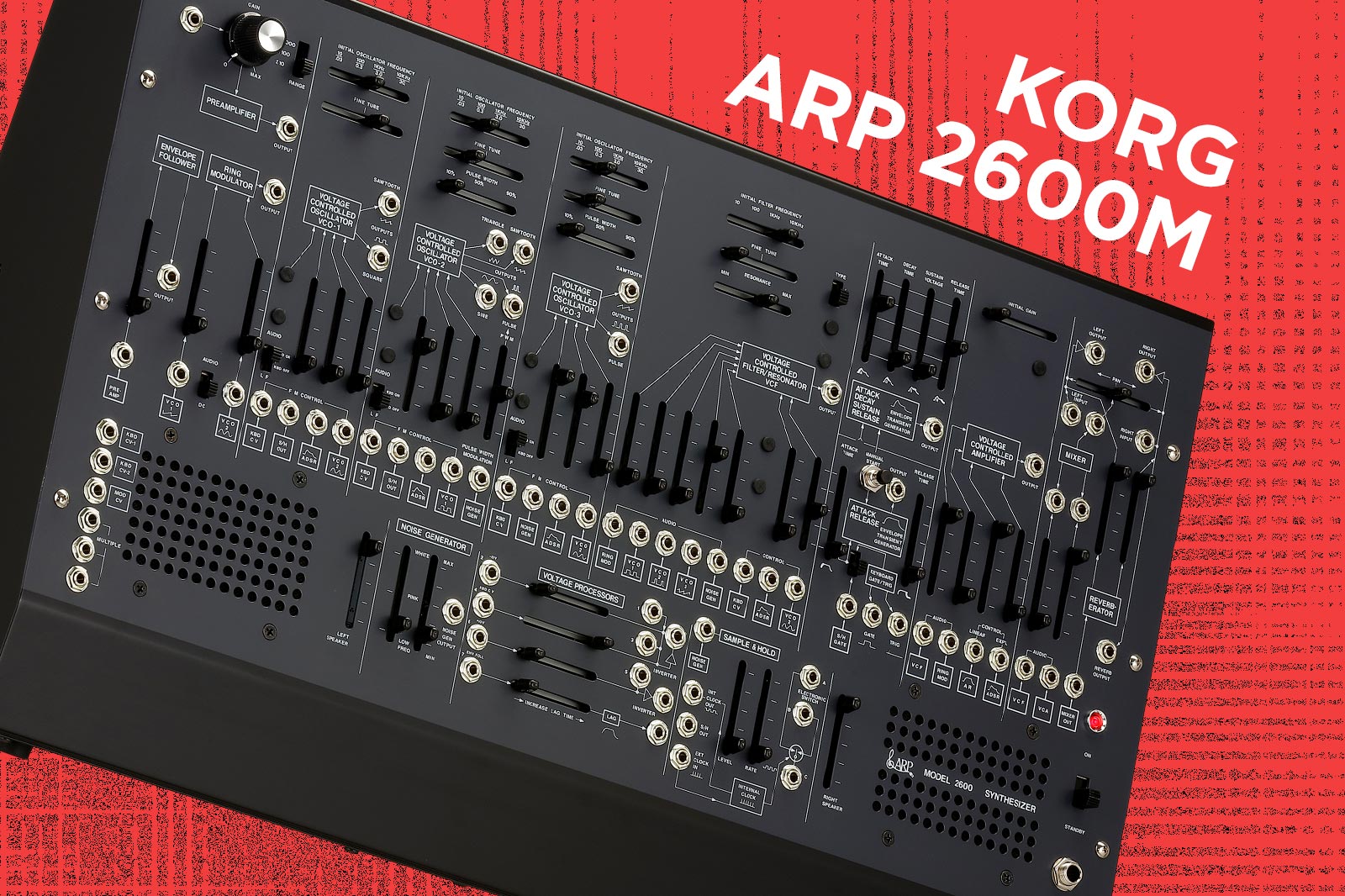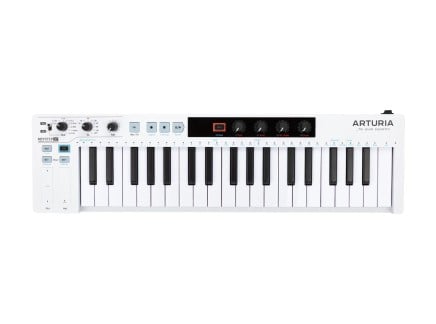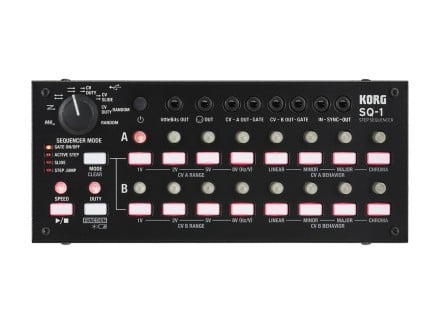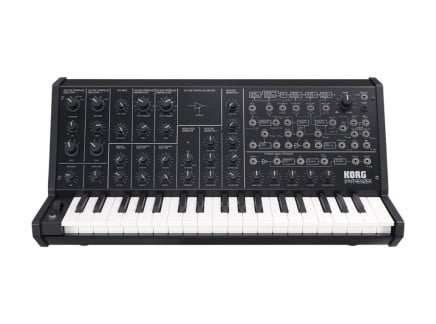At long last, Korg has announced the availability of the ARP 2600 M, a miniaturized but otherwise faithful reproduction of the classic ARP 2600 semi-modular synthesizer. With all of the same features and deep analog tone of the 1970s original, the 2600 M promises to bring the sound and feel of one of the most iconic synthesizers of all time to more hands than ever before.
The 2600 M features the exact same layout and functionality as the vintage ARP 2600, just at 60% the original size. It's not built into a tolex-laden case, but it does ship with a hard case with roller wheels and handle, great for rolling from gig to gig. Otherwise, it's a full-on (but smaller) 2600: same oscillators, filter, signal routing options, spring reverb, and yep...even the built-in speakers. Like Korg's previous limited-edition full size 2600 reissue, the 2600 M features a switch for selecting between early and late filter designs for a wide range of tonal options. So yes, if you've been waiting for a faithful sonic reproduction of the 2600 at a much more reasonable price than vintage or full-size Korg reissues...it's here.
This new instrument is available in two versions. The limited-edition ARP 2600 M LTD (now sold out!) includes a carry case, ARP sticker set, and a Korg microKEY2-37 keyboard MIDI controller, so that you can plug directly into the synthesizer and get straight to playing. The standard ARP 2600 M still includes the case and stickers, but does not include the keyboard controller.
In so many words, we're quite excited about this instrument finally arriving; in many ways, it has seemed to be on the horizon for nearly a decade. But if you're not already familiar, why is Korg making an ARP 2600? And...what makes a 2600 so special, anyway?
Korg and the Analog Resurgence
The years surrounding 2010 are commonly referred to in the synth marketplace as being pivotal years in the present-day "analog resurgence." Eurorack modular synthesizers were starting to catch on, and large instrument manufacturers were beginning to experiment with producing analog synth designs after years of making only "virtual analog" and digital instruments. It felt clear at the time that Korg in many ways was leading this charge; and many of the instruments in those days strongly felt like they were working up to something big.
Korg's first steps in this direction came with the modest pocket-sized Monotron (2010), their first analog synthesizer in ~25 years. This was followed by 2011's Monotribe, a battery-powered analog groovebox with integrated monosynth and drum machine, and then by 2012's Monotron Duo and Monotron Delay...two alternate takes on the modest Monotron's architecture/form factor.
The clearest breakthrough came, though, with 2013's MS-20 Mini...a miniaturized reproduction of their own classic 1970s monosynth.
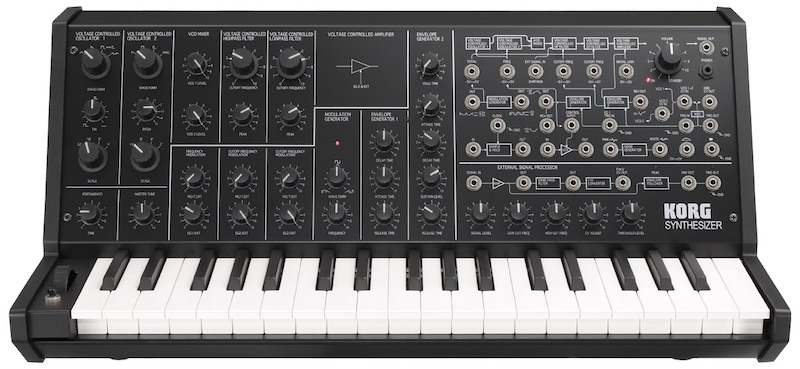
At the time of its release, the MS-20 Mini answered a long-standing public request: for many, it was the first truly affordable patchable, semi-modular, all-analog synth to have been released in decades. And moreover, it ticked all the right boxes in satisfying people's sense of nostalgia about analog instruments. After all, many musicians at this point were looking to the past and saying "Wow, they really don't make synths like an MS-20 or ARP 2600 anymore." Directly answering this call with a true-to-the-original design, the MS-20 was, simply put, a hit. As of the time of writing this article, the MS-20 Mini is still available for purchase.
It quickly became clear that analog synthesizers were picking up steam, and more and more new analog synths started to come along from all sorts of companies. Korg continued with the Volca series—a set of original designs seemingly improving on the Monotribe's mold.
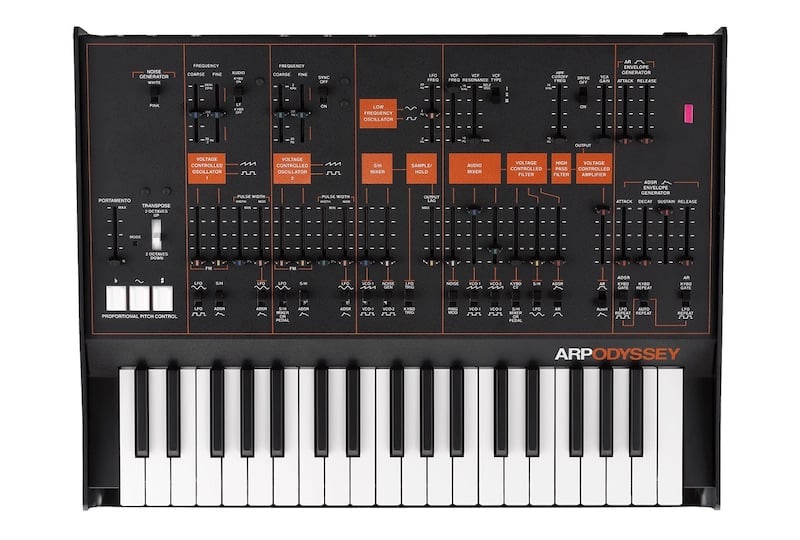
But in 2015, Korg took a quite surprising turn in introducing the Korg ARP Odyssey: a miniaturized but true-to-the-original reproduction of the original ARP Odyssey. The success of their own MS-20 Mini release seemed to have led to an agreement with ARP co-founder David Friend...and by all accounts, the instrument borne from their collaboration sounded and behaved completely true to the original Odyssey design. Korg had simply resumed production of this much-loved classic keyboard synth, updating its design while keeping the original sound intact.
Of course, a company like Korg suddenly issuing an officially licensed ARP Odyssey immediately raised a big question: what about the 2600?
Why the ARP 2600?
For many musicians, the ARP 2600 has been the long-standing "holy grail" of synthesizers. It's a bit difficult to pin down precisely what has given this 1970s design such staying power and historical resonance, but we can speculate. Part of it has to do with its visible use on quite a lot of popular music, from Stevie Wonder to Herbie Hancock to Jean Michel Jarre. Part of it has to do with the form factor: it's a synthesizer built into a suitcase, and when you sit in front of it, you feel like you're at the control center of a retro-futuristic spaceship. (See below: the new ARP 2600 M alongside Korg's limited edition ARP 2600 full size reissue.)
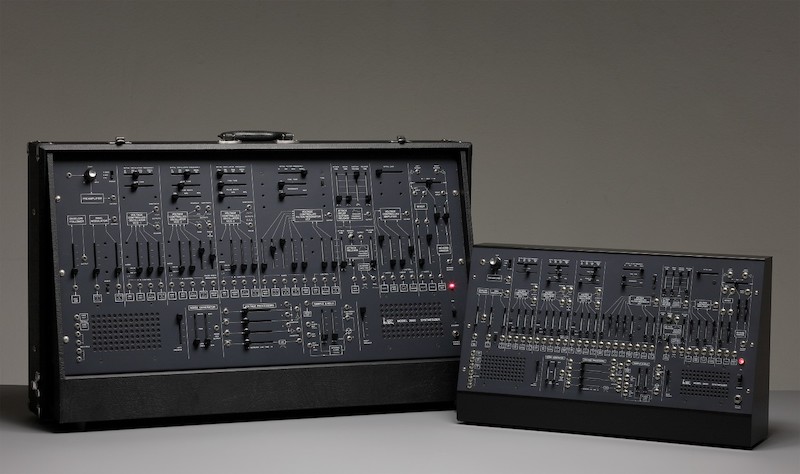
But of course, a large part of it has to do with its (at the time) unique semi-modular design. It provides all the best aspects of a hardwired keyboard synth and a modular synthesizer: you can sit right down and play a melody without needing to use any patch cables...and you can get to an astonishing range of sounds simply by adjusting various slider and switch settings. When you start patching, though, the 2600's sheer flexibility becomes immediately obvious: it's a full-fledged modular synthesizer, great for everything from thundering drones or soaring melodies to the most peculiar of generative, robotic soundscapes. In this way, the 2600 has a stronger general appeal and an arguably wider sonic range than many self-contained synths of its era...and as such, it has become something of a legend. (Note—if you want to get deep into the history and functionality of the ARP 2600, I strongly recommend checking out this in-depth overview of a vintage ARP 2600.)
So, when Korg announced a partnership with ARP with they Odyssey, it felt clear to basically everyone that a Korg 2600 could be in our future. Years came and went, and in early 2020, Korg announced the ARP 2600 FS, a full-size reissue of the classic instrument, completely with MIDI, updated keyboard functionality, and a host of new features. But, much to our dismay, the 2600 FS was an extremely limited edition, and they sold out nearly instantly.
In early 2021, though, Korg more directly answered the question we'd been asking since the 2015 release of the Odyssey: they announced the ARP 2600 M, a reduced-size instrument electronically identical to their full-size reissue. Today, I'm happy to report that—after over a year of waiting—the 2600 M is finally available, and I couldn't be more excited. Now that we've taken a look at Korg's roadmap up until this moment, let's take a quick look at what's actually in the 2600 M.
What's New on Korg's ARP 2600 M?
As I've said above, the 2600 M packs all the features of the original 2600 into a smaller package. The assortment of modules present in this instrument makes for a hugely flexible sonic toolkit. Based on straightforward analog synthesis concepts, the 2600 M might seem fairly simple at first—but its power lies in the ability to freely re-route signals and combine all of these simple elements into something greater than the sum of their parts.
Let's quickly address what's new in the 2600 M before discussing the core of the 2600's architecture. Notably, the 2600 M doesn't include the same style of keyboard as an original ARP 2600—but in its place, it does have MIDI input (via DIN and USB device connection). Additionally, it has a USB-A Host port...meaning that you can actually plug a USB MIDI controller right in and start playing immediately. Any class-compliant USB MIDI controller capable of sending note information should work nicely for these purposes; but again, remember that the 2600M LTD does include a microKEY2-37 for specifically this purpose. Pitch bend, modulation, and portamento on/off commands are also supported.
The 2600 M is, of course, re-sized—and it uses standard 3.5mm jacks rather than the original's 3.58mm Tini-Jax. The new version features both the 4012 and 4072 lowpass filters (selectable via front-panel switch), dedicated left and right channel 1/4" outputs, and a number of improvements to envelope stage time controls, trigger signal responses, and a few other simple quality-of-life improvements.
What Isn't New on Korg's ARP 2600M?
Like the original, the 2600 M features a preamp for external signals, an envelope follower, a ring modulation, three oscillators, a lowpass filter, two envelope generators, a VCA, panner, spring reverb, sample and hold, noise source, a variety of control voltage processing utilities, and a pair of surprisingly good-sounding built-in speakers. Many of these stages feature dedicated signal mixers as well, making it possible to achieve quite complex, huge analog sounds. Like the original, the 2600 M is basically a "monosynth," but it's possible to coax out duophonic/paraphonic textures from incoming MIDI using the KBD CV-1 and KBD CV-2 jacks. (That's a pretty snazzy trick that previously would've only been possible via the 3620 keyboard.)
Looking at the middle of the panel, you'll note a straight line of patch points from left to right, each with a white text label below and sliders above. These jacks and sliders are the core of the 2600's workflow: each patch point represents a modulation or audio routing destination, and each slider determines the amount of audio or modulation applied to that specific point in the circuit. The white labels below the jacks indicate what audio or modulation source is normalled to these destinations—that is to say, they represent hardwired, behind-the panel connections between a specific source and each destination. These hardwired connections can be overridden by patching another signal into the jack in question. All in all, this is the core of the 2600's flexibility: it makes it possible to access most typical modulation/audio routings without needing to use patch cables, but still offers the full flexibility of patching (like a modular synth) at the same time.
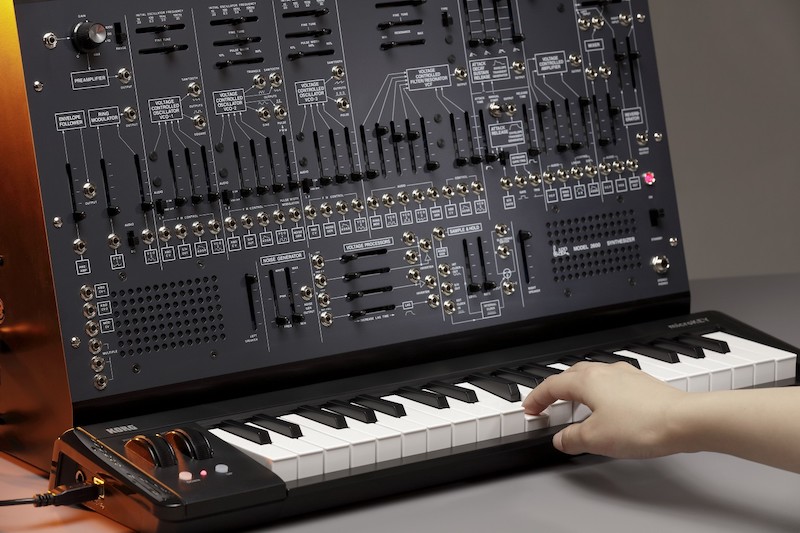
When playing the 2600 M, its sonic signature becomes immediately clear. It excels at deeply modulated textures via oscillator FM, ring modulation, and filter cutoff frequency modulation. The lowpass filter allows access to both revisions of filter design, for everything from weighty Moog-like response to more acid, squelching resonant tones. The filter can self-oscillate, creating singing, sine-like tones; the oscillators can each function in audio or LFO range; the sample and hold clock or oscillators can trigger the envelopes, the reverb can be coaxed into creating feedback, the voltage processors allow a wide range of complex functionality...the list goes on.
The 2600's strength is that, while it is an amazing sounding synth for bass lines, leads, and other classic synth tones...at the same time, it feels like an open-ended field of sonic exploration. Something about its user interface invites experimentation, leading you to completely re-discover even the most familiar of synthesis building blocks. In almost no time, you'll be completely re-learning what an oscillator or a filter can be good for. You'll re-think the usefulness of mixers at different points in your signal path. You'll discover new ways of breaking out of the "typical" subtractive synth signal flow. You'll discover bizarre, sometimes terrifying, and universally charming new ways of embracing complex modulation. And most importantly...you'll have an absolute blast the entire time.
Is the Korg ARP 2600 M a Good Synth?
So, is the ARP 2600 M a good synth? I'll answer that question with a resounding YES—the 2600 M is an amazing synth that, for my purposes, captures the sound and much of the unique magic of the original. My only personal misgiving is that there's something quite nice about the larger size of the original...but in terms of functionality and sound, it's spot-on.
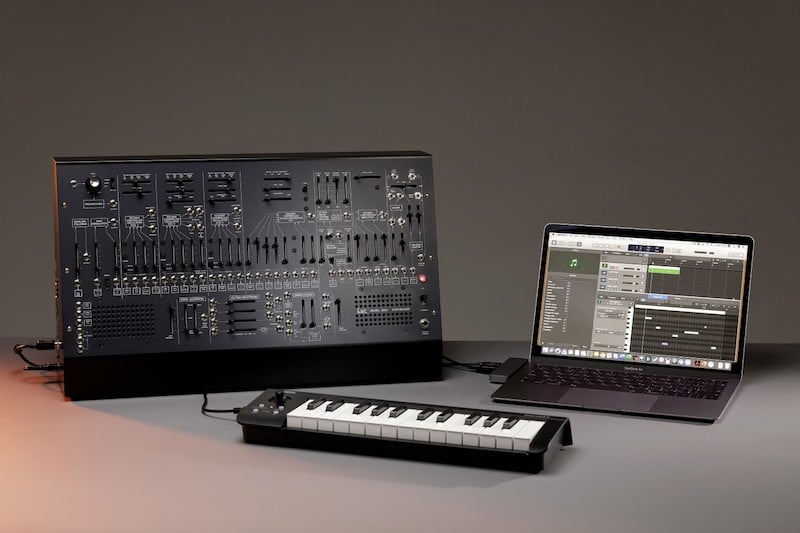
So, who is the 2600 M a good choice for? If you're a vintage synth enthusiast who is hesitant to spend the money on an original, this is an amazing alternative. If you're an educator looking for an excellent tool for teaching synthesis, this is a classic choice. If you're a musician with a tight studio space or a compact performance rig, this is an amazing way to add timeless analog tones to your setup. If you're just getting into synthesis or modular synths, but you're looking for a serious instrument you can dig into and explore for years to come, this thing will last the test of time.
Generally speaking? If you're an adventurous listener and have a love of classic analog synthesis, you can't go wrong with an ARP 2600. It's one of the most exciting and fun synths ever made, even now over 50 years after its initial release—and I'm thrilled to see it available once again.

